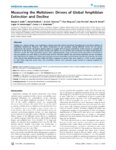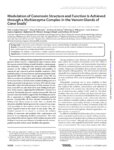|
|
Creator | Title | Description | Subject | Date |
| 351 |
 |
Sekercioglu, Cagan | Measuring the meltdown: drivers of global amphibian extinction and decline | Habitat loss, climate change, over-exploitation, disease and other factors have been hypothesised in the global decline of amphibian biodiversity. However, the relative importance of and synergies among different drivers are still poorly understood. We present the largest global analysis of roughly ... | | 2008-01-01 |
| 352 |
 |
Beckerle, Mary C.; Yoshigi, Masaaki; Hoffman, Laura M.; Yost, H. Joseph | Mechanical force mobilizes zyxin from focal adhesions to actin filaments and regulates cytoskeletal reinforcement | Organs and tissues adapt to acute or chronic mechanical stress by remodeling their actin cytoskeletons. Cells that are stimulated by cyclic stretch or shear stress in vitro undergo bimodal cytoskeletal responses that include rapid reinforcement and gradual reorientation of actin stress fibers; howev... | Zyxin; Actin | 2005 |
| 353 |
 |
Hughes, Kelly T.; Chevance, Fabienne | Mechanism of outer membrane penetration by the eubacterial flagellum and implications for spirochete evolution | The rod component of the bacterial flagellum polymerizes from the inner membrane across the periplasmic space and stops at a length of 25 nm at the outer membrane. Bushing structures, the P- and L-rings, polymerize around the distal rod and form a pore in the outer membrane. The flagellar hook stru... | Flagellar assembly; Spirochete evolution; Membrane penetration | 2007 |
| 354 |
 |
Beckerle, Mary C. | Members of the zyxin family of LIM proteins interact with members of the p130cas family of signal transducers | Integrin binding to extracellular matrix proteins induces formation of signaling complexes at focal adhesions. Zyxin co-localizes with integrins at sites of cellsubstratum adhesion and is postulated to serve as a docking site for the assembly of multimeric protein complexes involved in regulating ce... | Zyxin; Actin; LIM domains; Trip6; Focal adhesions | 2002 |
| 355 |
 |
Blair, David F. | Metal centers of cytochrome c oxidase: structures and interactions | Studies directed toward the elucidation of the structures of the metal centers in cytochrome c oxidase are reviewed. Progress towards an understanding of the interactions between these centers and their spatial distributions within the protein will also be presented. Our studies are based primarily... | | 1983 |
| 356 |
 |
Potts, Wayne K. | MHC signaling during social communication | The major histocompatibility complex (MHC) has been known to play a critical role in immune recognition since the 1950s. It was a surprise, then, in the 1970s when the first report appeared indicating MHC might also function in social signaling. Since this seminal discovery, MHC signaling has been f... | | 2012-01-01 |
| 357 |
 |
Capecchi, Mario R. | Mice lacking endothelial ACE: normal blood pressure with elevated angiotensin II | Recently, the concept of local renin-angiotensin systems (RAS) capable of generating angiotensin II apart from the circulation has received considerable attention. To investigate this, we generated ACE 1/3 mice in which one allele of ACE is null and the second allele was engineered to express ACE o... | | 2003 |
| 358 |
 |
Capecchi, Mario R. | Mice lacking endothelial angiotensin-converting enzyme have a normal blood pressure | To test the hypothesis that local vascular production of angiotensin II is necessary for the normal regulation of blood pressure, we engineered a new line of genetically altered mice that lack endothelial angiotensin-converting enzyme (ACE). This was accomplished using a novel strategy of targeted... | | 2002 |
| 359 |
 |
Capecchi, Mario R. | Mice with cardiac-restricted angiotensin-converting enzyme (ACE) have atrial enlargement, cardiac arrhythmia, and sudden death | To investigate the local effects of angiotensin II on the heart, we created a mouse model with 100-fold normal cardiac angiotensin-converting enzyme (ACE), but no ACE expression in kidney or vascular endothelium. This was achieved by placing the endogenous ACE gene under the control of the α-myo... | Atrial enlargement; Cardiac arrhythmia; ACE | 2004 |
| 360 |
 |
Capecchi, Mario R. | Mice with enhanced macrophage angiotensin-converting enzyme are resistant to melanoma | Angiotensin-converting enzyne (ACE) is a pepitdase responsible for the cleavage of angiotensin I and Several other peptides. Here, gene targeting was used to switch control of the ACE locus from the endogenous promoter to the macrophage-specific c-fms promoter. Challenge of these mice, called ACE 10... | Macrophage enzyme; Melanoma resistance; Enhanced macrophage angiotensin-converting enzyme | 2007 |
| 361 |
 |
Capecchi, Mario R. | Mice with targeted disruptions in the paralogous genes hoxa-3 and hoxd-3 reveal synergistic interactions. | The Hox genes encode transcription factors which mediate the formation of the mammalian body plan along the anteroposterior and appendicular axes. Paralogous Hox genes within the separate linkage groups are closely related with respect to DNA sequence and expression, suggesting that they could have ... | Animals; Atlas; Homozygote; Mice; Models, Genetic | 1994-07-28 |
| 362 |
 |
Beckerle, Mary C. | Microinjected fluorescent polystyrene beads exhibit saltatory motion in tissue culture cells | Microinjected 0.26-um fluorescent, carboxylated microspheres were found to display classical saltatory motion in tissue culture cells . The movement of a given particle was characterized by a discontinuous velocity distribution and was unaffected by the activity of adjacent particles. | Organelles; Microscopy; Proteins | 1984 |
| 363 |
 |
Davidson, Diane W. | Microtopography of microbiotic crusts on the Colorado Plateau, and distribution of component organisms | We analyzed the microtopography of microbiotic soil crusts at 3 sites on the Colorado Plateau of southern Utah and investigated distributions of cyanobacteria and several lichens in distinctive microhabitats created by this topography. At all 3 sites the long axes of linear soil mounds were oriented... | Microtopography; Microbiotic crusts; Colorado Plateau; Cryptobiotic soil; Colonization; Nonrandom orientation; Exposure; Collema; Disturbance history; Microhabitat | 2000 |
| 364 |
 |
Adler, Frederick R. | Migration alone can produce persistence of host-parasitoid models | It has long been recognized that the unstable equilibrium of a single-patch predator-prey model cannot be stabilized by diffusive coupling with identical patches, since the coupled system acts exactly like the single-patch system if the patches are synchronized (Maynard Smith 1974; Allen 1975; Reeve... | Heterogeneity; Nicholson-Bailey; migration rates | 1993 |
| 365 |
 |
Capecchi, Mario R. | Modeling alveolar soft part sarcomagenesis in the mouse: a role for lactate in the tumor microenvironment | Alveolar soft part sarcoma (ASPS), a deadly soft tissue malignancy with a predilection for adolescents and young adults, associates consistently with t(X;17) translocations that generate the fusion gene ASPSCR1-TFE3. We proved the oncogenic capacity of this fusion gene by driving sarcomagenesis in m... | | 2014-01-01 |
| 366 |
 |
Seger, Jon | Models of sex ratio evolution | Our understanding of sex ratio evolution depends strongly on models that identify: (1) constraints on the production of male and female offspring, and (2) fitness consequences entailed by the production of different attainable brood sex ratios. Verbal and mathematical arguments by, among others, D... | Fitness; Species; Sex-allocation | 2002 |
| 367 |
 |
Olivera, Baldomero M. | Modulation of conotoxin structure and function is achieved through a multienzyme complex in the venom glands of cone snails | Background: Conotoxins can be utilized to investigate enzyme-assisted folding of disulfide-rich peptides. Results: Various ER-resident cone snail enzymes act in concert to accelerate the oxidative folding of conotoxins and modulate their conformation by reconfiguring disulfide connectivities. Conclu... | | 2012-01-01 |
| 368 |
 |
Jorgensen, Erik | Molecular basis of synaptic vesicle cargo recognition by the endocytic sorting adaptor stonin 2 | Synaptic transmission depends on clathrin-mediated recycling of synaptic vesicles (SVs). How select SV proteins are targeted for internalization has remained elusive. Stonins are evolutionarily conserved adaptors dedicated to endocytic sorting of the SV protein synaptotagmin. Our data identify the m... | | 2007 |
| 369 |
 |
Beckerle, Mary C. | Molecular characterization of human zyxin | Zyxin is a component of adhesion plaques that has been suggested to perform regulatory functions at these specialized regions of the plasma membrane. Here we describe the isolation and characterization of cDNAs encoding human and mouse zyxin. | Zyxin; Proline; LIM domains | 1996 |
| 370 |
 |
Beckerle, Mary C. | Molecular dissection of a LIM domain | LIM domains are novel sequence elements that are found in more than 60 gene products, many of which function as key regulators of developmental pathways. The LIM domain, characterized by the cysteine-rich consensus CX2CX16_23HX2CX2CX2CX16_21CX2-3(C/H/ D), is a specific metal-binding structure tha... | LIM domains; Metal-binding; Zyxin; Cysteine-rich proteins | 1997 |
| 371 |
 |
Beckerle, Mary C. | Molecular dissection of zyxin function reveals its involvement in cell motility | Spatially controlled actin filament assembly is critical for numerous processes, including the vectorial cell migration required for wound healing, cell-mediated immunity, and embryogenesis. One protein implicated in the regulation of actin assembly is zyxin, a protein concentrated at sites where t... | Zyxin; Actinin; Ena/VASP | 1999 |
| 372 |
 |
Olivera, Baldomero M.; Bandyopadhyay, Pradip K. | Molecular phylogeny of some Indo-Pacific genera in the subfamily Turrinae H. Adams and A. Adams, 1853 (1838) (Gastropoda: Neogastropoda) | We have carried out a phylogenetic analysis of a group of Indo-Pacific species in the subfamily Turrinae (Swainson, 1840) using 128 mitoehondrial ribosomal RNA gene sequcnces Most of the species analyzed are convenlionally assigned to one of there Lophiotoma Casey, 1904. The inolecular anaysis revea... | Turrinae; Indo-Pacific; Mitochondrial RNA; Molecular phylogeny | 2007 |
| 373 |
 |
Clayton, Dale H. | Molecular phylogeny of the dove genera Streptopelia and Columba | Evolutionary history of the dove genus Streptopelia has not been examined with rigorous phylogenetic methods. We present a study of phylogenetic relationships of Streptopelia based on over 3,600 base pairs of nuclear and mitochondrial gene sequences. | Doves; Streptopelia; Columba | 2001 |
| 374 |
 |
Clayton, Dale H. | Molecular phylogeny of the dove genus Zenaida: mitochondrial and nuclear DNA sequences | We reconstructed a phylogeny for the seven species of doves in the genus Zenaida on the basis of a combined analysis of mitochondria (ND2 and cytochrome b) and nuclear (fibrinogen intron 7) DNA sequences. This phylogeny, which is completely resolved, is well supported with all nodes showing greater... | Molecular phylogeny; Dove; Nuclear DNA | 2000 |
| 375 |
 |
Bohs, Lynn A. | Molecular phylogeny of the Solanaceae | A phylogeny of Solanaceae is presented based on the chloroplast DNA regions ndhF and trnLF. With 89 genera and 190 species included, this represents a nearly comprehensive genus-level sampling and provides a framework phylogeny for the entire family that helps integrate many previously-published phy... | Biogeography; Chloroplast DNA; Chromosome evolution; ndhF; trnLF | 2008 |

























